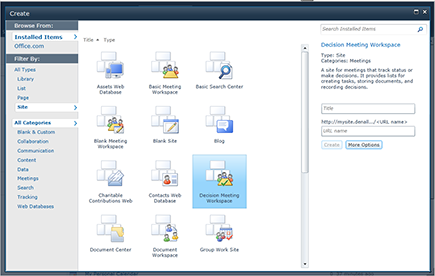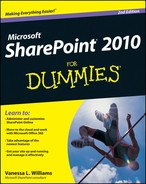Figure 16-1: The default My Content page on your My Site.
Chapter 16
Using My Site Effectively
In This Chapter
![]() Storing your documents and information on My Site
Storing your documents and information on My Site
![]() Keeping your private stuff private
Keeping your private stuff private
![]() Using sites to collaborate with others
Using sites to collaborate with others
![]() Creating and maintaining a blog
Creating and maintaining a blog
Your My Site is more than just a place to think about every once in a while when you need to update your profile. It’s a great place to use on a regular basis to share information with others, store your work, collaborate with others, and communicate with your colleagues.
Using Your My Site to Save Stuff
There are many different places that you can store the stuff you work on and depend on — on your desktop, on your local hard drive, online via something like SkyDrive or Dropbox — or you can simply use your My Site to store your important stuff.
Some of the advantages of using your My Site include
![]() It’s backed up on a regular basis. Confirm this with your IT team, or if you’re using Office 365 you can be assured that it is.
It’s backed up on a regular basis. Confirm this with your IT team, or if you’re using Office 365 you can be assured that it is.
![]() It’s got the same familiar SharePoint interface that you know and love, so you can create extra columns for tracking metadata about your files.
It’s got the same familiar SharePoint interface that you know and love, so you can create extra columns for tracking metadata about your files.
![]() You can make some of your stuff public so you can share with others in your company, but you can also have a place where you store stuff that you don’t want other people looking at.
You can make some of your stuff public so you can share with others in your company, but you can also have a place where you store stuff that you don’t want other people looking at.
That last point is really quite interesting. If you look at Figure 16-1, you’ll notice across the top of the page that the My Content page is activated. And on this page, you’ll see two libraries that are on everyone’s My Content page by default (you can of course customize this page to your heart’s content).
The first library you see there is Shared Documents. This is where you can store the stuff you want other people to see. Maybe it’s work-related and maybe it’s not, but it’s something that you want others to be able to access when they ask you about it. You can even right-click and copy the link, and then send it to them in a message. As long as they are on the network or can access their own SharePoint My Site, they can access your document.
The other library you see in the main part of the page is called Personal Documents. And that’s just what it is — a place where you can store your files that you don’t want to share with everyone.
The way this works, from a SharePoint point of view, is that everyone has Read permissions to your My Site, but the Personal Documents library has unique permissions. Only the person who owns the My Site has permissions to that document library, and nobody else has any permissions at all except for the System Account, which is similar to how your company’s mail server is set up as well.

The great thing about your My Content site is that you’re not limited to these two or three libraries. You can create any number of lists and libraries in this site however you see fit. There are two things to keep in mind, however, when creating other lists and libraries:
1. Each new list or library that you create is accessible by everyone in your company. To change this, you have to break permissions inheritance and remove anyone who shouldn’t have access:
1. After you create your new list or library, browse to it and click the List (or Library) Settings on the Library Ribbon.
2. In the Permissions and Management section, click the Permissions for this List (or Library) link.
3. As pictured in Figure 16-2, the Permissions page is displayed. Click the Stop Inheriting Permissions button.
4. Then remove anyone who shouldn’t have access (you can also add anyone here that you want to give access to).
2. Many My Sites (and, in turn, My Content sites) are limited in the amount of space they can consume. So check with your SharePoint administrator to see if he has set a My Site quota. For Office 365, the limit is 500MB per My Site.
Figure 16-2: Managing permissions in a My Content site.

Creating Your Own Collaboration Space
In addition to creating list and libraries on your My Content site, you can also create additional sites. Think of it as your own personal SharePoint site that you can do with as you please because, really, that’s exactly what it is. You just have to remember that your entire My Site is limited in capacity by the SharePoint farm administrator.
But don’t let that slow you down. You’ve seen the default home page of your My Content site in Figure 16-1, but did you notice that Site Actions menu in the upper left, just below My Site and just above the left-hand navigation? If you’re not used to managing SharePoint sites and site collections, this menu may be new to you, so click on it and check out the options you have here.
You can
![]() Sync to SharePoint Workspace: That’s right, you can work with your My Site through SharePoint Workspace just as you would any other SharePoint site. For more information about SharePoint Workspace, see Chapter 6.
Sync to SharePoint Workspace: That’s right, you can work with your My Site through SharePoint Workspace just as you would any other SharePoint site. For more information about SharePoint Workspace, see Chapter 6.
![]() Create a new document library.
Create a new document library.
![]() Create a new site.
Create a new site.
![]() Get to a page (by clicking More Options) that allows you to create any type of list, library, page, or site.
Get to a page (by clicking More Options) that allows you to create any type of list, library, page, or site.
![]() View all site content: This is really handy when you’re needing to figure out exactly what you’ve created. It can be used as a jumping-off point for getting to the same list you’ll see if you clicked More Options.
View all site content: This is really handy when you’re needing to figure out exactly what you’ve created. It can be used as a jumping-off point for getting to the same list you’ll see if you clicked More Options.
![]() Edit the site in SharePoint Designer.
Edit the site in SharePoint Designer.
![]() See the site permissions.
See the site permissions.
![]() Get to the site settings.
Get to the site settings.
As shown in Figure 16-3, clicking the More Options menu takes you to the Create dialog, which is the go-to place for creating all things related to your My Content site. You have full access to create anything you want to based on the templates shown here because you’re essentially the site administrator.
The best part about your SharePoint My Site is that you have complete control over it. You can do whatever you want to it and nobody’s really going to notice or care. If you’ve wanted to play around with SharePoint but nobody’s ever given you the chance, this is your chance. Take a look around, do some digging, and don’t be afraid. Most things you can do in SharePoint are reversible, so feel free to play around. The worst case scenario is that you break something and have to ask the administrator to restore it.
Figure 16-3: Creating a new site to collaborate with your colleagues.

While you’re playing around, create a new site. To do this, follow these steps:
1. Click the Site Actions menu and select More Options.
2. The Create dialog is displayed, which shows you all the things that you can create — lists, libraries, pages, and sites, as shown in Figure 16-3.
3. If you’re wondering what a Decision Meeting Workspace is all about, create one of those (you can always delete it later).
A Decision Meeting Workspace is useful if you need to track task assignments, store documents, and record why and when decisions are made. You also get lists for Objectives and Agendas, making it clear to participants what the meeting’s about.
Just remember: The sub-sites you create inherit permissions from the main My Content site, so everyone has at least the rights to view the site. You will probably want to change these to give at least some people the ability to Contribute to the site. Also, feel free to use this as your own personal playground to figure out what SharePoint has to offer. It’s a great way to explore and get more out of your company’s investment.
Reaching Out with a Blog
There are many ways to share information within your company. You can send an e-mail, publish a document to your portal, or maybe go real old-school and leave a hard copy in everyone’s physical inbox.
But nothing really compares to a good blog. It’s a bit like reading a book with really short chapters. As shown in Figure 16-1, your My Content site has a link for creating your own blog. Clicking on that link actually does just that — it creates your very own blog with an entry that describes how to use it. What actually happens behind the scenes is that a new blog site is created under your personal site, so the URL becomes
http://mysite.<your company>.com/personal/<your name>/blog/default.aspx.
Your blog posts show up on your My Content home page and a link to your blog site is listed under the Sites section of the left hand navigation. Clicking that link to your blog takes you to the main page of your blog site.
As shown in Figure 16-4, your blog site contains some useful links. Notice that you see Categories on the left side and a link to add a new category. You’ll also see an Archives section that shows you past months. This makes is easy for readers of your blog to navigate through and find topics of interest.
On the right side, you have links to the blog tools. Here you can create, edit, and delete posts and manage comments that people make on your blog.
So what is so special about a blog? Nothing, really, except for the content you create in it. Blogging is not for everyone, but if you feel like sharing your thoughts with your colleagues, and you know that you can post at least a few times a month, your blog might be compelling to your coworkers.
Creating and maintaining a blog is a great way to communicate what you’re working on, your ideas about the latest company initiative, or what’s going on in your life that you think others may find interesting. The topic of your blog can be about a single thing or can range from the Amazon to Zambia. It doesn’t really matter (unless you start violating some HR policies), but what matters to your readers is that you create posts that are interesting to read and you’re updating your blog on a semi-regular basis.
Figure 16-4: The layout of your blog’s home page.


